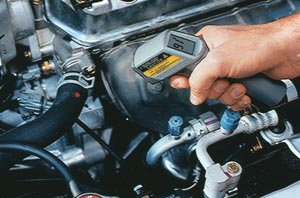 Being able to measure temperature variances can play an important roll in diagnosing vehicle maladies for both undercar and underhood technicians. This can be easily accomplished by using a non-contact infrared thermometer. With this tool, technicians simply point the thermometer at the area of concern and they are immediately provided with the temperature of the surface in question. Some of these thermometers are equipped with precision lasers that can help the technician pinpoint the area being tested. No physical contact is necessary. This is especially useful when needing to measure the temperature of items that are very hot, electrically live or rotating. Using a thermometer can decrease the risk of technicians getting hurt on the job.
Being able to measure temperature variances can play an important roll in diagnosing vehicle maladies for both undercar and underhood technicians. This can be easily accomplished by using a non-contact infrared thermometer. With this tool, technicians simply point the thermometer at the area of concern and they are immediately provided with the temperature of the surface in question. Some of these thermometers are equipped with precision lasers that can help the technician pinpoint the area being tested. No physical contact is necessary. This is especially useful when needing to measure the temperature of items that are very hot, electrically live or rotating. Using a thermometer can decrease the risk of technicians getting hurt on the job.
Depending on the thermometer, temperatures can be measured from approximately -25° to 1,500° F. Temperatures are measured very quickly with an accuracy usually within one degree, displayed in either Celsius or Fahrenheit. Some models can store up to a couple hundred readings and can display the highest and lowest readings measured, or provide the technician with an average of all the readings. If the technician wants to permanently store the temperature readings, some thermometers can be hooked up to a computer and the information can be downloaded for future study.
As with any piece of shop equipment, it’s important to investigate and study the different options available so you can choose the one that best fits your shop’s needs. Non-contact infrared thermometers range in price from around $60 up to $500. This is a piece of equipment that will be used quite often in the shop, so be sure to test a few out to see which options would be of assistance in diagnosing and servicing vehicle problems in the most efficient manner.
These hand-held tools are battery powered and some are equipped with a flashlight that conveniently illuminates the area being measured. This feature can come in handy when working in a dark engine compartment.
This is a piece of equipment every shop should have as it can be used for engine, exhaust, brake, heating and cooling, and other general undercar and underhood service. The following are specific examples of situations in which non-contact infrared thermometers can be used to assist in the diagnostic process.
EXHAUST
One way to see if a catalytic converter is working is to look for an increase in temperature as the exhaust passes through it. To check the temperature on either side of the converter, technicians in the past have had to drill small test ports into the pipes and insert a temperature or pressure probe inside to measure exhaust temperatures.
While this method works, it requires additional labor to weld or plug the holes after the readings have been obtained. When using a non-contact infrared thermometer, all the technician needs to do is point the gun at the pipe and record the temperature readings. If no difference in temperature is recorded, this would indicate a defective converter or no air from the air pump. If this is the case, the air pump diverter valve and plumbing will need to be checked. A large increase in temperature indicates the converter is overheating because of a rich fuel condition, misfiring spark plugs or compression leaks.
BRAKES
One problem that can cause a customer’s vehicle to pull to one side is related to the brake system. A stuck brake caliper can cause the brakes to remain applied even when the driver takes his foot off the brake pedal. One way to diagnose this problem is to compare the heat emanating from each wheel. Having a non-contact infrared thermometer allows the technician to quickly measure the temperature at each brake system. If one wheel is noticeably hotter, there is a brake problem and the technician can eliminate the suspension and steering systems from being the source of the customer complaint.
THERMOSTAT
A bad thermostat is often blamed for causing an engine to overheat. You can check the thermostat by starting the engine and using a non-contact infrared thermometer to check the temperature of the upper radiator hose. When the engine is first started, the temperature readings should not be very high. However, this hose will heat up as the engine warms up and the thermostat opens. If the technician does not experience this rise in hose temperature, it means the thermostat is not opening.
Another way to test the thermostat is to remove it and dip it into a pan of boiling water. Its exact temperature when it opens can be checked using a thermometer.
RADIATOR
When diagnosing a problem with the radiator, if blockage is suspected, a non-contact infrared thermometer can help out here as well. The technician can use the thermometer to scan the surface of the radiator for cold spots when the engine is hot and idling. If there appears to be a blockage, or blockages, that is preventing the radiator from carrying out its cooling responsibilities, the radiator will have to be removed and cleaned, or replaced.











